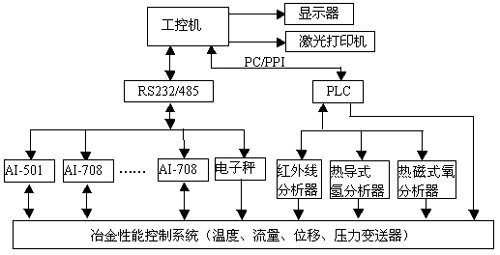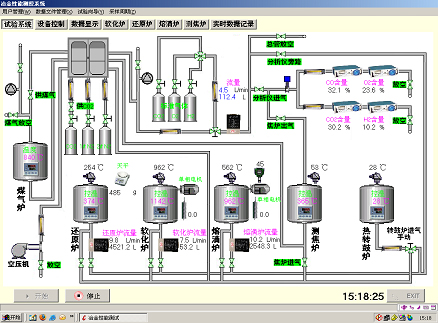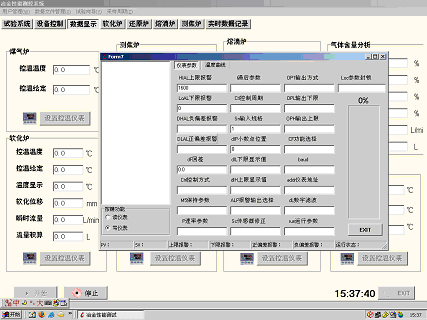**Abstract:**
The AI intelligent regulator enables precise temperature control and monitoring of electric furnaces, as well as the detection of temperature, pressure, flow, displacement, and weight loss. Integrated with an industrial control system, it forms a distributed control solution, which is applied in metallurgical performance measurement and control systems. The system offers reliable operation, strong anti-interference capability, and high control accuracy, making it ideal for demanding industrial environments.
**Introduction:**
The blast furnace smelting system is a complex process that requires detailed analysis. This system simulates the behavior of temperature, pressure, flow, displacement, and weight loss during the smelting process, establishing a comprehensive laboratory for metallurgical performance measurement and control. Experimental results guide the smelting process, ensuring optimal conditions. The system uses a distributed control structure, where the AI intelligent instruments from Xiamen Yudian provide accurate temperature control, while the PLC manages process switching, analog signals, and timing functions. An industrial computer centralizes management, and the AIBUS+ communication protocol supports RS485 interfaces, allowing the system to monitor 19 channels of temperature, flow, pressure, and displacement through serial communication.
**1. Hardware Components of the Control System**
The system primarily controls 11 large electric furnaces along with their auxiliary equipment, gas treatment, and detection components. In addition to temperature, parameters such as load softening displacement, material weight, gas flow, and pressure during reactions, as well as droplet count during melting, are monitored. These data are collected by on-site AI smart meters and transmitted via a bus. The system architecture is illustrated in Figure 1.
**Figure 1: Hardware Block Diagram**

**1.1 Control Mode Selection**
The system mainly focuses on precise temperature control. The AI intelligent instrument offers various modes, including position control (ON-OFF), standard PID, AI-based APID or MPT. Most electric furnaces use standard PID, which meets process requirements. Users can adjust parameters like M5, P, and t for custom settings. For special systems, self-tuning is enabled, offering self-learning, no overshoot, and precise control, ensuring stable performance.
**1.2 Stepwise Power Limiting Mode**
Most furnaces are resistance-type, while some high-temperature ones use silicon-molybdenum rods. To prevent excessive current at low temperatures, power segmentation is used. By setting CF, the meter limits output based on temperature thresholds, effectively preventing dangerous overcurrent situations during initial heating.
**1.3 System Commissioning**
For certain furnaces, temperature gradients are calculated using wall temperature data, reducing pure hysteresis and improving control. Adjustments like Sc correct inconsistent start conditions. During commissioning, the AI meter’s self-tuning function is utilized, with parameters like M5, P, and t set for optimal performance. Control accuracy is less than ±1°C, with maximum overshoot under 2°C.
**2. Software Structure and Function of the Control System**
The system has a two-layer architecture, with the upper layer being an industrial control computer for centralized control and data processing, and the lower layer managed by PLC and on-site AI instruments. It includes manual and automatic control options for smooth switching. The main interface is shown in Figure 2.
**Figure 2: Main Interface Diagram**

**Main Features:**
- **Human-Machine Interaction:** Displays real-time data, parameter curves, switch controls, historical data, alarm status, and AI meter settings.
- **Database Management:** Stores and exports real-time and historical data into Excel.
- **User and System Management:** Different roles (administrator, operator, security officer) have distinct permissions, enabling customized settings for sampling frequency, refresh intervals, and alarms.
**Figure 3: Instrument Settings and Data Display**

**3. Conclusion**
The system has been successfully implemented in Guangdong Shaoguan Iron and Steel Plant. It is safe, reliable, and highly efficient. Combining AI regulators, PLCs, and industrial computers, the distributed control system delivers excellent anti-interference capabilities and precision, meeting all required performance standards.
Foshan Gruwill Hardware Products Co., Ltd. , https://www.zsgruwill.com